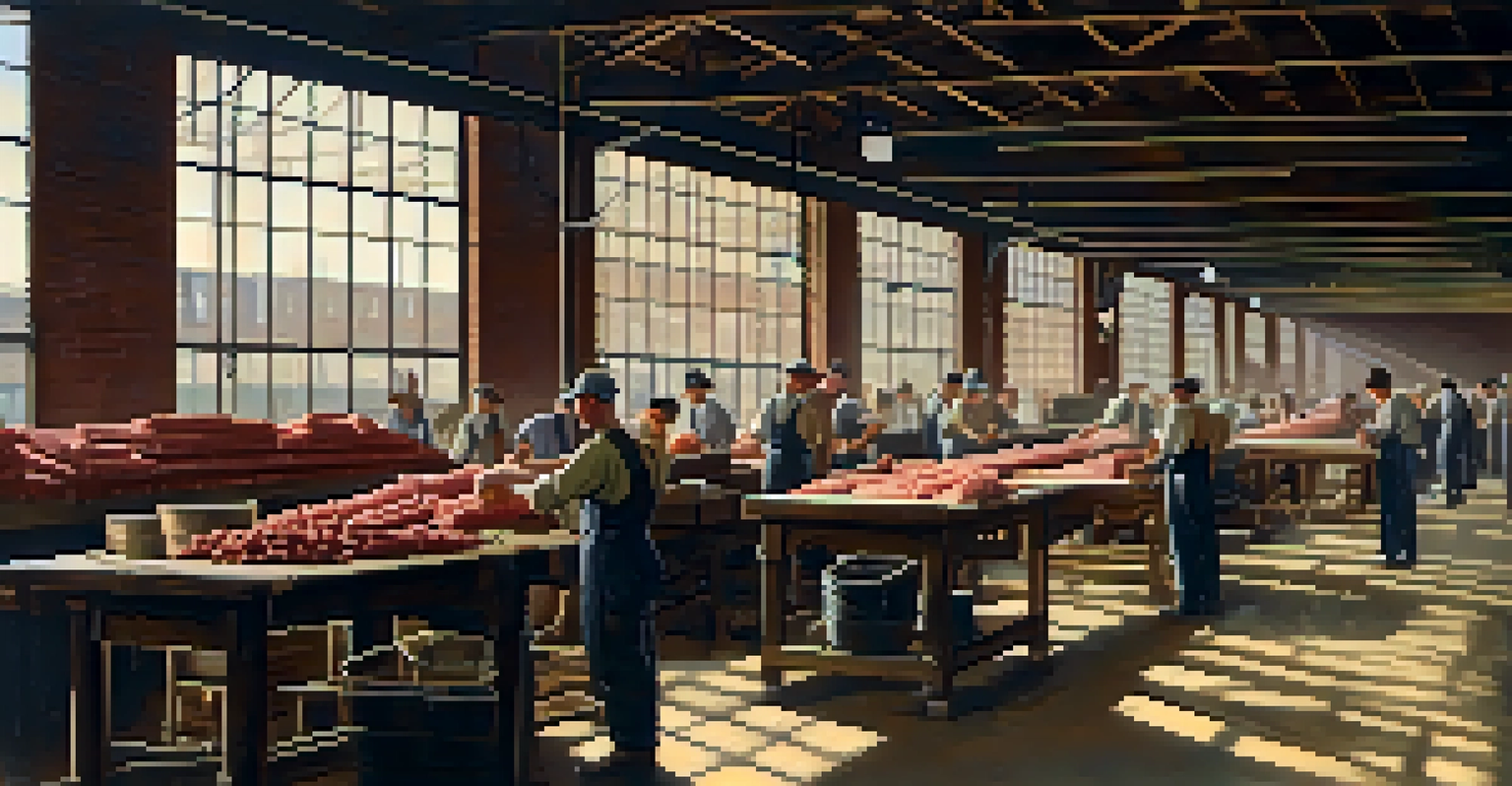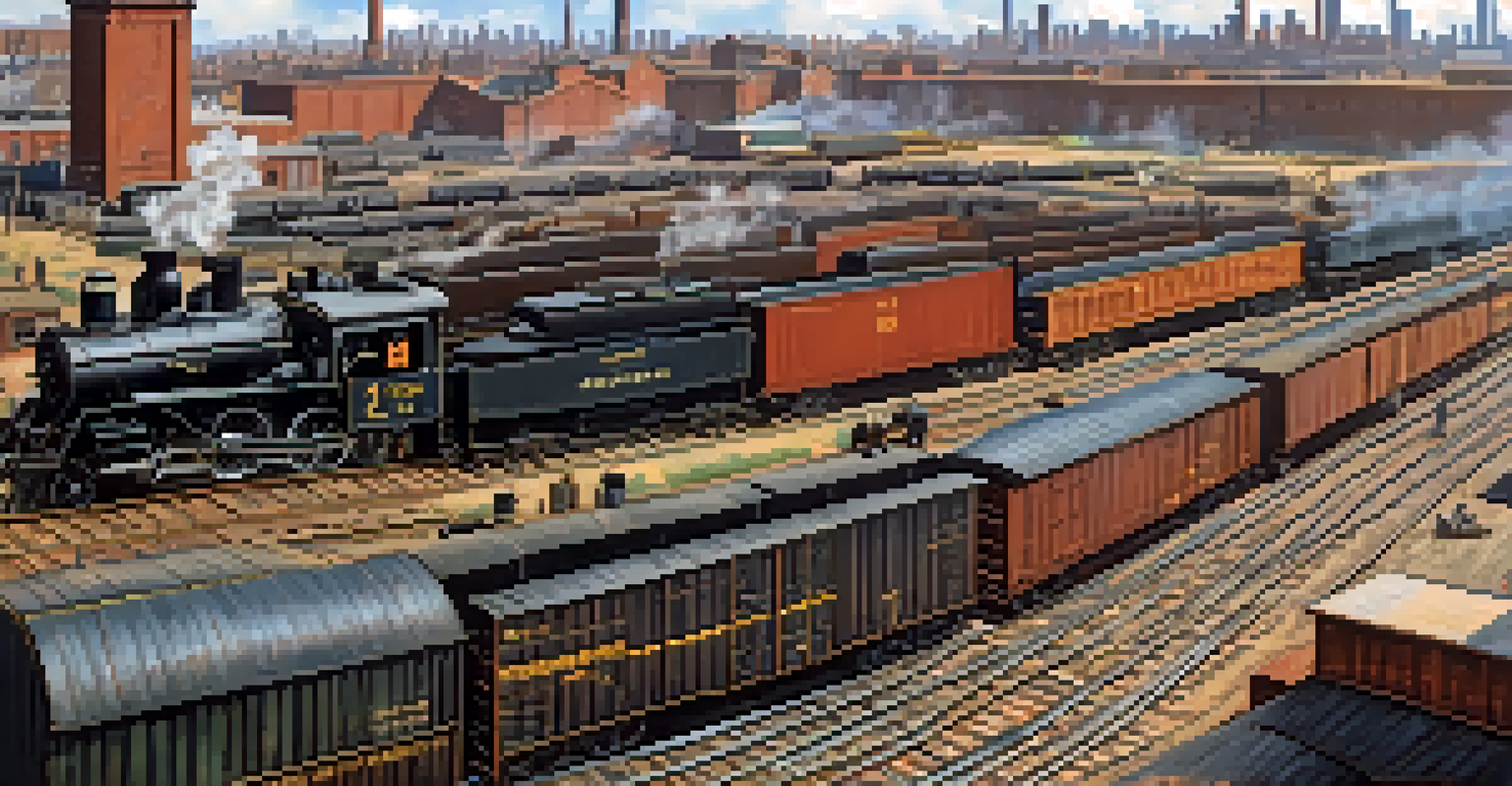Chicago's Role in the Industrial Revolution

The Birth of a Manufacturing Hub in Chicago
In the mid-19th century, Chicago emerged as a manufacturing powerhouse, thanks to its strategic location. Nestled near major transportation routes, it became a crucial link between the East and the West. This accessibility not only attracted businesses but also facilitated the movement of goods and resources, making it a prime spot for industries to thrive.
Chicago is an enormous city, a city of the world; the people are busy, and the city is alive with the sound of industry.
The city's growth was fueled by the construction of railroads, which connected Chicago to various markets across the nation. By the time the Civil War broke out, these rail lines had transformed the city into a bustling center of trade and commerce. Factories sprang up, producing everything from machinery to food products, further cementing Chicago's status as a manufacturing hub.
Chicago's role in the Industrial Revolution was not just about quantity; it was also about innovation. Entrepreneurs in the city began experimenting with new production techniques, which laid the groundwork for modern industrial practices. This culture of innovation attracted skilled labor and encouraged the development of new technologies.
The Influence of Immigration on Industrial Growth
As industries flourished, Chicago became a magnet for immigrants seeking better opportunities. Waves of European immigrants arrived, bringing diverse skills and labor to the city's factories. This influx not only fueled industrial growth but also contributed to the city's vibrant cultural tapestry, with communities forming around shared languages and traditions.

The labor force in Chicago was diverse, with workers from Ireland, Germany, Poland, and Italy playing critical roles in the industrial sector. These immigrants often took on tough, low-paying jobs, but their contributions were invaluable in keeping factories running. Their hard work and resilience became the backbone of Chicago's economic expansion during the Industrial Revolution.
Chicago Became an Industrial Powerhouse
Chicago's strategic location and innovative spirit fueled its emergence as a key manufacturing hub during the Industrial Revolution.
However, the rapid growth of industries also led to challenging working conditions. In response, labor movements began to rise, advocating for better wages and safer workplaces. This struggle for workers' rights would shape not only Chicago but also the broader labor landscape across the United States.
Chicago's Role in the Meatpacking Industry
One of the most iconic industries that emerged in Chicago during the Industrial Revolution was meatpacking. The city's location made it ideal for processing livestock, and soon, it became the meatpacking capital of America. Facilities like the Union Stock Yards became synonymous with the industry, attracting both cattle and workers from all over.
The labor movement is the primary vehicle for social change in America.
Innovations in refrigeration and transportation played a pivotal role in transforming the meatpacking industry. Chicago's meatpackers were among the first to embrace these technologies, allowing them to ship fresh products across the country. This not only expanded their market reach but also changed the way meat was consumed in America, making it more accessible to the average consumer.
However, the meatpacking industry also faced scrutiny due to its practices and the working conditions within the plants. Upton Sinclair's novel 'The Jungle' famously exposed these issues, leading to reforms in food safety regulations. This highlighted the need for balance between industrial growth and ethical practices, a conversation that continues today.
The Railroads: Lifeblood of Industrial Chicago
Railroads were essential to Chicago's industrial success, facilitating the efficient movement of goods and raw materials. By the late 19th century, the city had become a major rail hub, with multiple lines converging at its center. This network not only supported local industries but also connected them to national and international markets.
The introduction of freight cars revolutionized how products were transported, allowing manufacturers to ship large quantities over long distances. This capability significantly reduced costs and opened up new markets for Chicago's goods. As a result, industries flourished, and the city solidified its reputation as an economic powerhouse.
Immigration Shaped Industrial Growth
The influx of European immigrants provided a diverse labor force that was crucial for the city's industrial expansion.
Moreover, the railroads were instrumental in attracting other industries to Chicago. Businesses recognized the benefits of being near such a robust transportation network, leading to an influx of companies setting up shop in the area. This symbiotic relationship between the railroads and local industries was a key factor in Chicago's rapid industrialization.
Innovation and Technology in Chicago's Factories
Chicago's factories became breeding grounds for innovation during the Industrial Revolution. Entrepreneurs and inventors were drawn to the city, eager to develop new machinery and production methods. This culture of experimentation helped propel the manufacturing sector forward, setting the stage for modern industrial practices.
One notable example is the introduction of assembly line techniques, which drastically increased production efficiency. By streamlining processes and minimizing waste, these innovations allowed Chicago's industries to meet growing demand while keeping costs down. This not only benefited manufacturers but also consumers, who enjoyed lower prices and more options.
Furthermore, Chicago's emphasis on education and technical training helped cultivate a skilled workforce. Institutions emerged to teach workers the necessary skills to operate advanced machinery, ensuring that the city stayed at the forefront of industrial advancements. This commitment to innovation and education would have lasting impacts on the economy and workforce.
The Impact of the Great Chicago Fire on Industry
The Great Chicago Fire of 1871 was a devastating event that transformed the city and its industries. While the fire destroyed a significant portion of the city, it also provided a unique opportunity for reconstruction and modernization. Many factories and buildings were rebuilt using new materials and designs that emphasized safety and efficiency.
In the aftermath of the fire, Chicago's industries showed remarkable resilience. Business leaders and workers came together to rebuild, leading to a renewed focus on innovation and quality. This period of reconstruction allowed the city to adopt advanced technologies, which further boosted its industrial capabilities.
Labor Movements Redefined Workers' Rights
Chicago's labor movements played a significant role in advocating for workers' rights, influencing labor laws nationwide.
Moreover, the fire prompted the implementation of stricter building codes and safety regulations. These changes not only improved working conditions but also set a precedent for urban planning and industrial development across the United States. The lessons learned from the fire shaped Chicago into a modern, thriving industrial city.
Labor Movements and Workers' Rights in Chicago
The rapid industrialization of Chicago also gave rise to significant labor movements advocating for workers' rights. As factories expanded and the workforce grew, laborers began to organize for fair wages, reasonable hours, and safe working environments. This collective action was crucial in improving the lives of many workers.
One of the most notable events in this movement was the Haymarket Affair of 1886, which highlighted the struggles for labor rights. A peaceful rally advocating for an eight-hour workday turned into a tragic confrontation that resulted in violence. This event galvanized labor unions and highlighted the need for reforms, leading to increased public awareness of workers' issues.

As a result, labor movements in Chicago played a pivotal role in shaping labor laws and regulations across the nation. The city became a symbol of the fight for workers' rights, influencing policies that led to better working conditions and fair treatment in industries nationwide. This legacy of advocacy continues to resonate today.
Chicago's Lasting Legacy in American Industry
Chicago's contributions to the Industrial Revolution left an indelible mark on American industry. The city's innovative spirit and robust manufacturing sector set the stage for future economic growth and development. Many practices and technologies that originated in Chicago became standard across industries nationwide, showcasing the city's influence.
Moreover, the diverse workforce and cultural dynamism contributed to a rich tapestry that defined Chicago's identity. The blending of different traditions and ideas fostered creativity, which was essential for industrial advancement. This cultural heritage continues to inspire innovation and entrepreneurship in the city today.
In sum, Chicago's role in the Industrial Revolution was multifaceted, encompassing manufacturing, labor movements, and technological advancements. The city's journey from a burgeoning settlement to an industrial powerhouse continues to be a source of inspiration, reminding us of the power of innovation, resilience, and community.